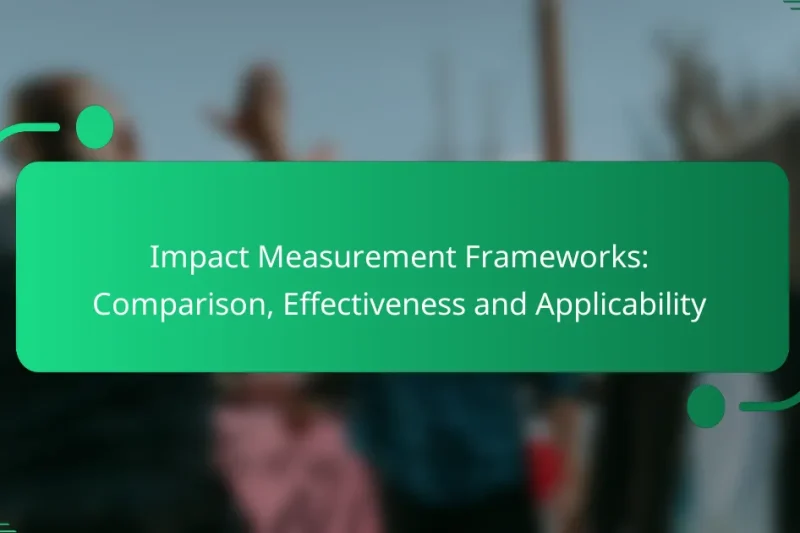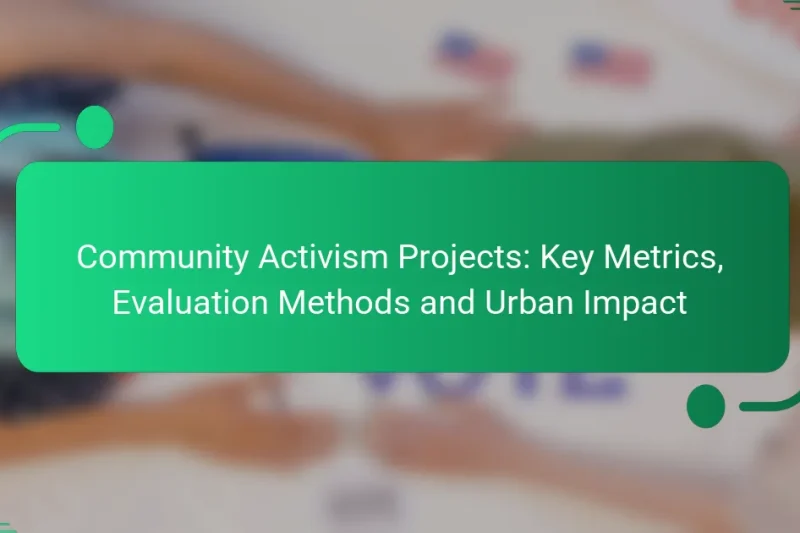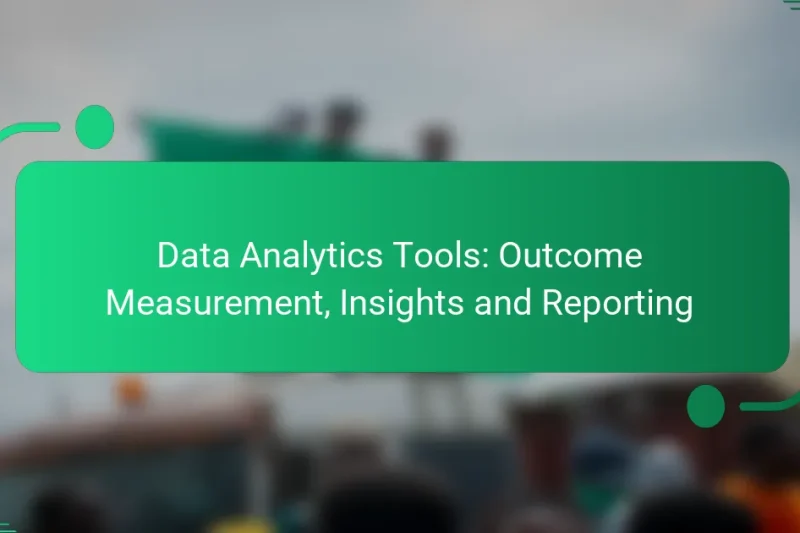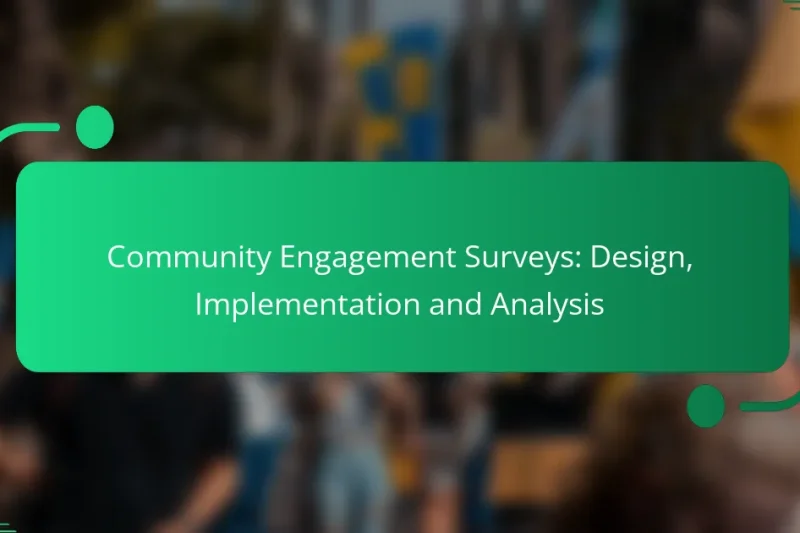Impact measurement frameworks play a crucial role in assessing and communicating the outcomes of various programs … Impact Measurement Frameworks: Comparison, Effectiveness and ApplicabilityRead more
Community Activism Media Projects: Impact Measurement
Community activism media projects play a vital role in fostering engagement and driving social change. To gauge their effectiveness, these projects utilize a blend of quantitative metrics, qualitative assessments, and participant feedback, offering a holistic view of their impact. By employing various frameworks and tools, organizations can evaluate their initiatives, enhance their strategies, and ensure accountability to stakeholders.
Community Activism Projects: Key Metrics, Evaluation Methods and Urban Impact
Community activism projects play a vital role in urban areas by enhancing quality of life and … Community Activism Projects: Key Metrics, Evaluation Methods and Urban ImpactRead more
Social Media Metrics: Engagement Rates, Reach and Conversion Tracking
Understanding social media metrics such as engagement rates, reach, and conversion tracking is essential for optimizing … Social Media Metrics: Engagement Rates, Reach and Conversion TrackingRead more
Data Analytics Tools: Outcome Measurement, Insights and Reporting
Data analytics tools play a crucial role in outcome measurement by offering insights into performance metrics … Data Analytics Tools: Outcome Measurement, Insights and ReportingRead more
Impact Reporting: Best Practices, Stakeholder Communication and Transparency
Impact reporting is crucial for organizations aiming to demonstrate their effectiveness and engage stakeholders meaningfully. By … Impact Reporting: Best Practices, Stakeholder Communication and TransparencyRead more
Activism Projects: Long-term Impact, Community Benefits and Sustainability
Activism projects play a crucial role in creating long-term impact by driving sustainable change within communities … Activism Projects: Long-term Impact, Community Benefits and SustainabilityRead more
Community Engagement Surveys: Design, Implementation and Analysis
Community engagement surveys are essential tools for gathering valuable insights from residents, enabling organizations to understand … Community Engagement Surveys: Design, Implementation and AnalysisRead more
How can community activism media projects measure impact?
Community activism media projects can measure impact through a combination of quantitative metrics, qualitative assessments, and direct feedback from participants. These methods provide a comprehensive view of how effectively the project engages the community and achieves its goals.
Quantitative metrics
Quantitative metrics involve numerical data that can be statistically analyzed to gauge the impact of a project. Common metrics include the number of participants, frequency of engagement, and reach of media content. For example, tracking the number of views or shares on a video can provide insight into its popularity and influence.
Additionally, metrics can be compared over time to assess growth or decline in community engagement. Setting specific targets, such as increasing participation by a certain percentage, can help measure success against defined goals.
Qualitative assessments
Qualitative assessments focus on the subjective experiences of participants and the community. This can include interviews, focus groups, or open-ended surveys that gather personal stories and feedback. Such assessments provide deeper insights into the emotional and social impacts of the project.
Analyzing themes from qualitative data can reveal how well the project resonates with the community and highlight areas for improvement. It’s essential to balance qualitative insights with quantitative data for a well-rounded understanding of impact.
Case studies
Case studies offer detailed examinations of specific instances where community activism media projects have succeeded or faced challenges. By documenting these experiences, organizations can identify best practices and common pitfalls. For instance, a case study might explore how a local campaign effectively mobilized residents to address a community issue.
These narratives can serve as powerful tools for advocacy and education, illustrating the tangible outcomes of activism efforts. Sharing case studies can also inspire other projects and foster collaboration within the community.
Surveys and feedback
Surveys and feedback mechanisms are essential for gathering direct input from participants and the broader community. Structured surveys can quantify satisfaction levels, perceived effectiveness, and areas needing improvement. Open feedback channels, such as suggestion boxes or online forums, encourage ongoing dialogue.
Regularly conducting surveys before and after project implementation can help measure changes in community attitudes and engagement. This feedback loop is crucial for adapting strategies and enhancing future initiatives.
Social media analytics
Social media analytics provide valuable insights into how community activism media projects are perceived online. Tools like Facebook Insights or Twitter Analytics can track engagement metrics such as likes, shares, comments, and follower growth. These metrics help assess the reach and impact of social media campaigns.
Monitoring social media sentiment can also reveal public perception and highlight areas where the project may need to adjust its messaging. Engaging with followers through comments and messages can further strengthen community ties and enhance project visibility.
What are effective tools for impact measurement?
Effective tools for impact measurement provide insights into how community activism media projects influence their target audiences. These tools help organizations assess engagement, reach, and overall effectiveness, enabling data-driven decisions to enhance their initiatives.
Google Analytics
Google Analytics is a powerful tool for tracking website traffic and user behavior. It allows organizations to measure key metrics such as page views, session duration, and user demographics, which can inform the effectiveness of online campaigns.
To get started, set up tracking codes on your website and define goals that align with your project objectives. Regularly review reports to identify trends and areas for improvement, focusing on metrics that matter most to your activism efforts.
Hootsuite
Hootsuite is a social media management platform that enables users to schedule posts and monitor engagement across various social channels. It provides analytics on post performance, audience growth, and engagement rates, helping organizations understand their social media impact.
Utilize Hootsuite’s reporting features to track metrics like shares, comments, and click-through rates. This data can guide your content strategy, ensuring that you focus on what resonates with your audience while avoiding common pitfalls like overposting or irrelevant content.
SurveyMonkey
SurveyMonkey is an online survey tool that allows organizations to gather feedback directly from their audience. It can be used to measure satisfaction, awareness, and the perceived impact of community activism initiatives.
Create targeted surveys to assess specific aspects of your projects, such as community needs or the effectiveness of messaging. Keep surveys concise and consider offering incentives to increase response rates, ensuring that you collect valuable insights for future planning.
Tableau
Tableau is a data visualization tool that helps organizations analyze and present data in an accessible format. It allows users to create interactive dashboards that can display various metrics related to community activism projects, making it easier to communicate impact to stakeholders.
To effectively use Tableau, import data from your impact measurement tools and create visualizations that highlight key findings. Focus on clarity and simplicity in your dashboards, ensuring that they convey the story behind the data without overwhelming the viewer.
What frameworks support impact evaluation?
Several frameworks can effectively support impact evaluation in community activism media projects. These frameworks help organizations assess their initiatives’ effectiveness, guiding improvements and demonstrating accountability to stakeholders.
Logic models
Logic models are visual representations that outline the relationships between resources, activities, outputs, and outcomes of a project. They help clarify how specific actions lead to desired impacts, making it easier to identify gaps and areas for improvement.
When creating a logic model, start by defining the project’s inputs, such as funding and personnel, followed by the activities undertaken. Then, outline the expected outputs and the short-term, intermediate, and long-term outcomes. This structured approach can help stakeholders understand the project’s intended impact.
Theory of change
A theory of change is a comprehensive framework that explains how and why a desired change is expected to occur in a particular context. It goes beyond a logic model by detailing the assumptions and external factors influencing the project’s success.
To develop a theory of change, identify the ultimate goal and work backward to map out the necessary preconditions for achieving that goal. This process often involves stakeholder engagement to ensure that diverse perspectives are considered. Regularly revisiting and revising the theory of change can help adapt to changing circumstances and improve project effectiveness.
How do community media projects in urban areas differ in impact measurement?
Community media projects in urban areas often focus on measuring impact through local engagement and partnerships, which can vary significantly from rural initiatives. These projects typically assess their effectiveness by evaluating community participation, feedback, and collaboration with local organizations.
Focus on local engagement
Local engagement is crucial for measuring the impact of community media projects in urban settings. Projects often utilize surveys, focus groups, and social media interactions to gauge community interest and involvement. For instance, a project might track participation rates at events or the number of local stories shared to understand its reach.
Effective measurement of local engagement can include qualitative feedback, such as testimonials from community members, and quantitative data, like attendance figures. This dual approach helps projects adapt their strategies to better serve the community’s needs.
Partnerships with local organizations
Partnerships with local organizations enhance the impact measurement of community media projects by providing additional resources and insights. Collaborating with nonprofits, schools, and local businesses can lead to shared goals and improved outreach, making it easier to assess collective impact.
For example, a community media project might partner with a local school to create youth-led content, measuring success through student engagement and educational outcomes. These partnerships can also facilitate access to funding opportunities, which can be crucial for sustaining long-term projects.
What challenges do community activism media projects face in measuring impact?
Community activism media projects often struggle with measuring impact due to various challenges, including resource limitations, lack of standardized metrics, and difficulties in data collection. These obstacles can hinder the ability to effectively demonstrate the value and outcomes of their initiatives.
Resource limitations
Resource limitations are a significant challenge for community activism media projects, as they often operate on tight budgets and rely heavily on volunteer support. This can restrict their ability to invest in comprehensive evaluation tools or hire skilled personnel to analyze impact.
Many projects may not have access to advanced data collection technologies or platforms, making it difficult to gather and analyze relevant information. As a result, they might resort to basic methods, which can lead to incomplete or biased data.
To address resource limitations, projects should prioritize cost-effective evaluation strategies. Utilizing free or low-cost tools for surveys and social media analytics can help gather insights without straining budgets. Collaborating with local universities or organizations for support can also enhance evaluation efforts.





